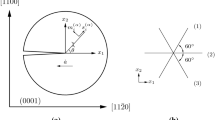Conclusion
The mechanical behavior of the discrete structure of a solid can be modeled by a linear system of three particles interacting in accordance with the approximate Born-Oppenheimer law with Lennard-Jones coefficients. Such a model manifests the following properties: elasticity (with small strains); plasticity (residual strains in the presence of two different equilibrium positions); viscosity (change in the frequency of the vibrations with an increase in the forces); hysteresis (with the jump of the middle particle from the left to the right equilibrium position and back); fusion (change in the frequency of the vibrations with an increase in strains).
The phenomenon of the interaction of three particles, referred to a linear chain of particles and an organic crystal model, offers a representation of the mechanism of crack opening in a discrete solid.
Similar content being viewed by others
Literature cited
M. V. Klassen-Neklyudova, Mechanical Twinning of Crystals [in Russian], Moscow (1960).
T. A. Kontorova and Ya. I. Frenkel', “Theory of plastic deformation and twinning,” Zh. Éksp. Teor. Fiz., No. 8, 89 (1938).
A. K. Malmeister, “Deformations and strength of a system capable of twinning,” in: Aspects of Dynamics and Dynamic Strength [in Russian], Vol. 2, Riga (1954), pp. 5–20.
A. K. Malmeister, “Deformation of a medium capable of twinning,” in: Aspects of Dynamics and Dynamic Strength [in Russian], Vol. 3, Riga (1955), pp. 97–122.
M. Ya. Leitane, “Duplication of a planar six-atom model,” Mekh. Polim., No. 4, 584–588 (1974).
V. F. Mezhgailis, “Internal stresses due to molecular interaction,” Mekh. Polim., No. 4, 741–743 (1974).
A. P. Dreimanis, “Dislocation mechanism of the initial stage of plastic deformation of polyethylene,” Mekh. Polim., No. 5, 771–777 (1974).
A. P. Dreimanis, “Transformation of a lattice in a model of a polymer crystal with a defect,” Mekh. Polim., No. 6, 992–997 (1974).
A. P. Dreimanis, “Energy characteristics of. mechanical twinning in a model of a polymer crystal with a defect,” Mekh. Polim., No. 2, 228–233 (1975).
M. Ya. Leitane, “Special case of deformation of a nine-atom model,” Mekh. Polim., No. 3, 545–547 (1975).
A. P. Dreimanis, “Plastic deformation of models of a crystalline polymer in hydrostatic tension,” Mekh. Polim., No. 1, 20–25 (1976).
M. Ya. Leitane, “Special case of twinning of a planar nine-atom model,” Mekh. Polim., No. 6, 1087–1089 (1975).
M. Ya. Leitane, “Evaluation of the surface tension of a fiber,” Mekh. Polim., No. 1, 12–14 (1977).
A. P. Dreimanis, “Plastic deformation of models of a crystallographic polymer with a high density of lattice defects,” Mekh. Polim., No. 3, 397–402 (1977).
V. F. Mazhgailis, “Interaction forces in a ten-atom model,” Mekh. Polim., No. 5, 914–940 (1977).
M. Ya. Leitane, “Surface forces in models of hexagonal and cubic crystalline plane structures,” Mekh. Polim., No. 5, 799–801 (1978).
M. Ya. Leitane, “Intermolecular surface forces of adsorptive interaction in a plane, close-packed hexagonal model,” Mekh. Kompozitn. Mater., No. 1, 156–167 (1979).
A. P. Dreimanis, “End defects in crystalline polyethylene. 1. Formulation of the problem and modeling of the three-dimensional structure of end defects,” Mekh. Polim., No. 3, 400–407 (1978).
A. P. Dreimanis, “End defects in crystalline polyethylene. 2. Transverse motion of defects and transverse strain of a defective crystallite,” Mekh. Polim., No. 4, 588–595 (1978).
A. P. Dreimanis, “End defects in crystalline polyethylene. 3. Formation of screw dislocations and longitudinal motion of defects,” Mekh. Polim., No. 5, 793–798 (1978).
A. K. Malmeister, “Certain aspects of the mechanics of a medium capable of twinning,” in: Aspects of Dynamics and Dynamic Strength [in Russian], Vol. 1, Riga (1953), pp. 22–43.
A. P. Dreimanis, “Effect of a lattice defect on the mechanism of local plastic deformation of a polymer crystal,” Mekh. Polim., No. 5, 784–790 (1975).
N. G. Rambidi and V. M. Zamalin, Intermolecular Microelectronics, Moscow (1985).
S. P. Timoshenko, Vibrations in Engineering [Russian translation], Moscow (1959).
Author information
Authors and Affiliations
Additional information
Translated from Mekhanika Kompozitnykh Materialov, No. 3, pp. 446–452, May–June, 1986.
Rights and permissions
About this article
Cite this article
Malmeister, A.K. Model of crack opening in a molecular crystal. Mech Compos Mater 22, 318–323 (1986). https://doi.org/10.1007/BF00608357
Received:
Issue Date:
DOI: https://doi.org/10.1007/BF00608357




